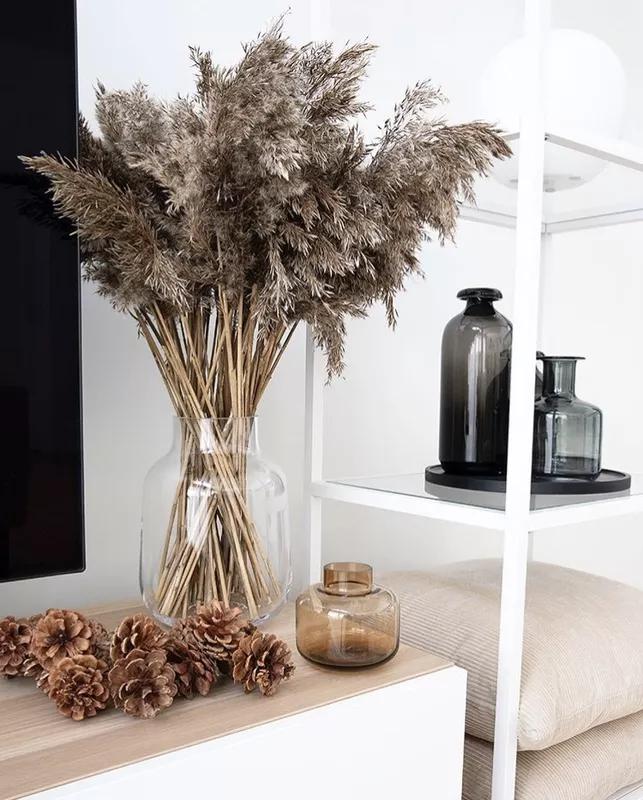Pampas grass specifications
- Scientific name : Cortaderia selloana
- Name : Pompas Grace or Pompas Grass
- Order : Poales
- Family : Poaceae
- Genus : Cortaderia
- Species : C. selloana
- Plant Type : Perennial
- Native Area : South America
- Flowers : Silver white spikes, sometimes with pink or purple tinge
- When To Sow : March, April, May
- Flowering Months : July, August, September, October
- When To Prune : February, March
- Plant propagation method : root division, seed planting
Pampas grass , the common name for Cortaderia selloana, is a flowering plant and ornamental grass native to Argentina, Brazil, and other regions of South America, and cultivated worldwide.
As a member of the Poaceae family, pampas grass is related to bamboo, rice, and wheat. The flowering plant is identifiable by its height, varying between four and 13 feet, and by an inflorescence or group of feathery plumes of flowers. Pampas grass also has green or yellow saw-toothed leaf blades with razor-sharp edges that form tufted clumps called tussocks.
read more : Everything about giant reed : How to Plant & care for them

What Are the Different Types of Pampas Grass ?
There are 25 different varieties of pampas grass within the Cortaderia selloana species. Among the most common are Gold Band, which has white plumes, and Pink Feather, a pink pampas grass with rose-colored blooms.
There is also a dwarf pampas grass (Cortaderia selloana pumila) and two pampas grass plants that are not in the selloana species : Cortaderia jubata, also known as Andean or purple pampas grass, and Saccharum ravennae, or hardy pampas grass.
- Cortaderia selloana ‘Pumila’ : Also known as dwarf pampas grass, this cultivator can be found with plumes that range from pale yellow to ivory. Because it is a compact variety, it grows up to five feet tall. This makes it a great choice for containers.
- Cortaderia selloana ‘Sunningdale Silver’ : As suggested by its name, this variety sports silver plumes. They grow up to 10 feet tall and are not as prone to clumping.
- Cortaderia selloana ‘Rendatleri’ : This “pink feather” cultivator is famous for its stunningly pink plumes and grows up to eight feet tall.
read more : Everything about palm plant : How to Plant & care for them
When to Plant Pampas
Pampas grass is a perennial grass, which means that it grows dormant during the winter months, and new growth occurs in the early spring. To grow this dioecious plant for fruit production, gardeners should plant separate male plants and female plants together for pollination.
Once you have viable pampas grass seeds, take them indoors and press them into cell packs or flats containing well-draining soil during the mid-to-late winter months. Ensure they have plenty of light and warmth (between 65 and 75 degrees Fahrenheit), and then transplant the seedlings for female plants (which have fuller plumes that don’t produce seed) in the spring.
How to Plant Pampas
While it’s possible to overwinter pampas grass indoors with the right combination of sun and light, it’s less effective and requires a lot of space as a year-round houseplant due to its height and razor-sharp leaves. Once the timing is right in your area, here’s a step-by-step guide to planting pampas from seed:
- Pampas grass requires a lot of sunlight to grow, so select a spot that gets a minimum of six hours of direct sun per day. They will also grow in partial shade, though the plants may be less healthy. Pampas grass is an invasive, self-seeding plant: a single plant can produce a million seeds per year, which, when carried by the wind, can grow wherever they land.
- Prepare the soil. Pampas grass needs rich and moist but well-drained soil to grow. You can till and add a balanced fertilizer or mulch to your garden or add quartz sand to assist with drainage.
- Plant the seeds. Once you’re ready to plant seedlings, dig a hole that’s about 15 inches deep. Massage the root ball to loosen the roots before planting, so they are in the best position to establish themselves in the soil. Place the plant in the hole, then fill it in with soil. If you’re planting multiples, ensure that there are at least six feet between each plant to give them ample room to grow.
- Water the site. Water the planting site deeply to settle the soil and help the seeds establish roots. After the roots take hold, the plant will only require watering every few weeks during the first year.
read more : Everything about lunaria plant : How to Plant & care for them
4 Tips for Growing Pampas
Here are a few tips on caring for your pampas grasses :
- Propagate : After approximately five years, your female pampas grass will need propagation to remain healthy. Propagating the plant will require you to cut the stalk down to the roots to reveal new shoots within the old plant. Remove the remains of the old plant and replant the young shoots at the same depth; water deeply and keep the soil moist until the new plant is thriving.
- Prune : Pampas grass grows quickly. To keep it under control, prune the grass stalk to the ground with gardening shears in late winter or early spring. Wear gloves and long-sleeve clothing to protect yourself from its sharp leaves.
- Fertilising : Pampas grass doesn’t need much in the way of fertiliser, but giving the plant a dose in spring, summer, and autumn of the first year will help it to reach full strength.
- Watering : Unless you’re living through particularly severe drought conditions, pampas grass won’t need watering. This plant hails from arid regions and is perfectly fine left to its own devices.
Iran dried pampas grass
If you want to create a dreamy atmosphere, the use of dried pampas grass is highly recommended. These dried grasses, while beautiful, is completely recyclable in nature and will always look beautiful in your space without being destroyed. The reasonable price of dried pampas grasses has made the sale and purchase of dried pampas grasses a great profit for the exporters and wholesalers of dried pampas grasses .
read more : Drying natural flowers | Introducing 8 wonderful ways to dry flowers

Dried pampas grass
Relocating and propagating
You can move established pampas grass by carefully uprooting it, then transplanting it into a hole just bigger than the root ball. Teasing the root ball gently apart and watering the soil gently after covering over will both help the transplanted grass to take better, and reduce the risk of trauma.
To propagate, replant a clump cut from an established plant. Female cuttings will take root and re-establish themselves. You can tell female plants by the more vibrant and showy plumes.
Notice : this article has been translated by google translate , if you have any questions or need more information Please contact us by writing a comment on this page.



0 Comments